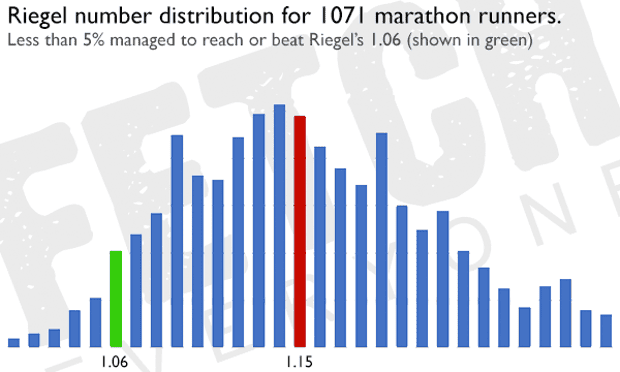- Roll
- Reminder: please keep the phones out of sight and sound.
- Your homework today was to read Riegel's paper, inspired
by our work on the cross country problem.
We'll be examining how Riegel's formula was derived (empirically), using linear regression.
- You have a new homework assignment to hand in on Monday.
- We had carried out our plans for homework, and so discussed our
conclusions.
- Some of your thoughts/highlights were incorporated into my final report.
On Friday, you will sign on, or dissent. Please read the report in preparation to either agree or dissent.
- Let's start with more "Reminders about modeling class versus
other classes":
-
Unlike most math classes, math modeling thrives on the open-ended question: there is generally no "right" answer; no "right" approach: but some may be better than others.
- All models are wrong; some models are useful. (attributed
to George Box).
-
Similarly, there are many ways to approach a problem: success may be
achieved by any number of different routes (and failure is easy!:).
An apocryphal story (but one too fun not to share!:): Neils Bohr and the barometer.
We value creativity and imagination more in math modeling than in nearly any other course. By the way, here is a mathematical model for calculating the height using a barometer in the boring way!
- All models are wrong; some models are useful. (attributed
to George Box).
- While there are many axes of math modeling, we'll be focused primarily on
these three:
- Continuous versus Discrete
- Deterministic versus Stochastic
- Empirical versus Mechanistic (or Structural)
I think of the last of these three is the most important. I generally like to talk about "pattern and process" (which "empirical and mechanistic" attempt to capture).
Mathematicians look for patterns. Absent any pattern, one does not attempt any modeling!
Once one identifies a pattern, one may model the pattern without understanding why it's there (empirical); but one begins to ask "why that pattern?", at which time one is moving towards identifying a process (structural) which causes that pattern.
-
- Empirical versus Mechanical Models
In the Niels Bohr example, the boring way for calculating the height using a barometer is an example of a mechanical/structural model: we understand the underlying physical properties which make the formula work.
As an example of an empirical model, I want to consider Riegel's formula(s). In particular, I want to focus on the genesis of the form of his model(s): linear regression, and the particular case used to estimate Thad and Thomas's times in my paper:
\[ t=2.299d^{1.07732} \]
All of you have, presumably, seen a little linear regression (it is technically a part of sta205, but it gets short shrift).
Riegel's last paragraph lays out exactly the empirical motivation of his equation: The endurance equation is not set forth as a fundamental theory of human locomotion. It is only a simple description of what is observed. I have tried to avoid speculation regarding physiological reasons for the effects noted in this article, preferring only to describe the reality as I have seen it. There are numerous ways in which equations may be fitted to data, and my choice of a power function is based on the desire to have an expression that represents a good compromise between accuracy and simplicity. I believe that the expression does represent such a compromise, as it is easily manipulated yet still projects times that come close to the world records at any distance within the endurance range. I hope that it will be a useful tool for those concerned with the application of the time-distance relationship to their own work or interests.
Let's take a look at this handout, showing how Riegel's formula is derived. (At this point, we're merely attempting to understand the use of linear regression; we will soon derive the equations of linear regression.)
- Prediction
calculators still give a rose-tinted view for most runners, says
Fetcheveryone's Ian Williams. He takes another look at the stats:
"Riegel's classic formula uses R=1.06, which still provides excellent
predictions for most distances even 40 years later -- but out of 1,071
marathon runners in our Fetcheveryone sample (all of whom had completed
at least five half and five full marathons), less than 5% managed a
time that kept up with Riegel's predictions. The rest fell short."
This on-line article begins by making the point that if you double your distance, then your time does not double -- but goes up by \[ 2^b \] So, if $d_2$ is twice $d_1$, then \[ T_2=T_1(\frac{d_2}{d_1})^{1.06}=T_1(2)^{1.06} \]
- And although they claim that it works well for most distances, it
doesn't seem to work well for marathoners:

(Thanks Sean)
- The Barometer question